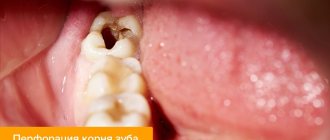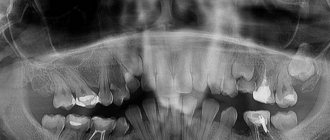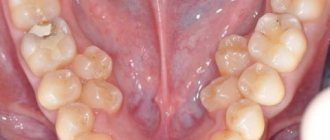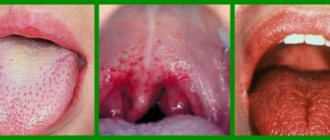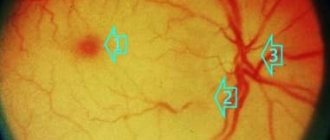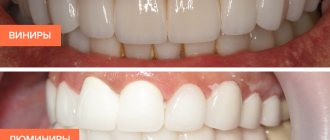The term “diathesis” in domestic medicine refers to a feature of the body’s constitution, which is expressed in a predisposition to certain diseases. Usually, diathesis refers to allergic diathesis, the most common and easily diagnosed. According to various sources, diathesis occurs in 30-75% of children.
Unlike allergies themselves, diathesis is not associated with functional disorders of the immune system. An allergic reaction during diathesis in infants is usually explained by the characteristics of the child’s body. In children of the first year of life, the protective function of the intestine is reduced: the intestinal walls are thin, the amount of enzymes and antibodies produced is small. As a result, the child’s body may not be able to cope with a large number of highly allergenic foods and give an allergic reaction. By two to three years, the amount of enzymes becomes sufficient, and diathesis in most cases goes away.
Symptoms of diathesis
Inflammation of the skin during diathesis is the body's reaction to contact with an allergen. The main way an allergen enters a child’s body is food, but a reaction to contact with the skin of the allergen is also possible (the allergen, for example, can be components of washing powder that get on clothes during washing, plant pollen, dust, animal hair, etc.).
Diathesis in children under 3 months of age
The first manifestations of diathesis most often appear at the age of 2-3 months. This:
- diaper rash that does not disappear even with careful care;
- profuse prickly heat with mild overheating;
- sebaceous crusts of gray-yellow color on the head in the hairline area (seborrhea).
Diathesis in children aged 3 months and older
In older children, a typical manifestation of diathesis is red spots on the cheeks. As the condition worsens, the skin becomes crusty. The crusts become wet, the child experiences discomfort, itches, becomes excitable, sleep and appetite may be disturbed, and loose stools may appear.
Diagnosis of food allergies in children
In many cases, people confuse a specific reaction of the body with individual intolerance. There are definitely some similarities between them, but we are talking about different pathologies. Excessive sensitivity appears after eating as a response of the body, while with intolerance the protective functions do not interfere. The main causes of intolerance are usually metabolic disorders of certain substances.
If signs of hypersensitivity appear, you should immediately consult a doctor. The specialist will take a detailed medical history to try to determine which factors are “dangerous” and establish a temporal relationship between food intake and the appearance of symptoms.
Skin tests can sometimes help diagnose a specific reaction. A positive result does not necessarily mean that sensitivity is present, but a negative result indicates that the patient is unlikely to be sensitive to such food. After receiving a positive skin test, an allergist may need to perform oral monitoring to make a definitive diagnosis.
Methods of treating diathesis
When dealing with diathesis in a young child, the main thing is to choose the right diet, excluding foods that may cause an allergic reaction.
For a child in his first year of life, it is very important to receive breast milk.
The proteins of human milk are easily broken down by the baby's enzymes and are completely devoid of allergic properties. However, a nursing mother must also follow a diet excluding fish, poultry, tomatoes, chocolate, smoked meats, spices and other allergenic foods.
When mixed feeding, the child should not be given some juices: orange, carrot, tomato. Introduce any new product carefully - from a small amount. It is important to prevent an allergic exacerbation, and at the same time, to give the baby’s body everything it needs for its development.
Specialist consultation
The Family Doctor pediatric allergist-immunologist will help you deal with your child’s skin problems, determine the cause of allergies, and also build a rational diet that is suitable specifically for your child.
Make an appointment Do not self-medicate. Contact our specialists who will correctly diagnose and prescribe treatment.
Rate how useful the material was
thank you for rating
Symptoms of food allergies in children
It appears in the first two hours after eating if the diet includes a dangerous factor. One or more organs are affected, including the skin, gastrointestinal tract, mucous membranes, respiratory and cardiovascular systems. The severity of the course depends on the reactivity of the affected organ, the general well-being of the patient and the characteristics of the factor causing the atypical response.
Main features:
- Skin manifestations. Urticaria is the appearance of a small rash. Accompanied by redness, itching and peeling. It is localized mainly on the face and neck, hands, forearms and elbows. It may become complicated when a bacterial infection occurs.
- Respiratory manifestations. Rhinitis is accompanied by nasal congestion, profuse watery discharge and repeated sneezing. In rare cases, a sore throat and coughing may occur.
- Airway involvement. In patients with asthma, bronchospasm may be present in the context of anaphylaxis (severe systemic condition). Anaphylaxis is dangerous because, if left untreated, it can be fatal.
- Damage to the gastrointestinal tract. Accompanied by diarrhea, abdominal pain, nausea and vomiting. The stool undergoes changes and most often becomes liquefied.
Other symptoms include itching in the mouth and throat, as well as in the eye area. Possible difficulty swallowing, dizziness, fainting, swelling of the eyelids, face, lips and tongue.
Jaw displacement and facial asymmetry: how to fix it at home
A normal person's face cannot be completely symmetrical.
The difference between the left and right sides is practically unnoticeable. You can identify small differences if you look closely at a photograph or carefully study a person. But in some cases, asymmetry is pathological in nature and this is the reason for contacting a specialist. In most cases, a clear violation of facial proportions is associated with jaw asymmetry. Let's talk about it in more detail.
Description of facial asymmetry
Normally, imbalances in proportions do not exceed 2-3 millimeters. The left side of the face is characterized by femininity and smoothness of features.
They are slightly elongated in the vertical plane.
The right side is slightly wider, more defined and sharp. But there are also pronounced facial asymmetries associated with profound disorders.
It is not difficult to distinguish physiological deviations from pathologically disturbed proportions. To do this, just look in the mirror. The deformity is expressed in a skewed chin, noticeable displacement of the corners of the mouth, one cheekbone higher than the other.
Jaw displacement is not only a problem of aesthetics, the bite is also disturbed, bruxitis may begin to develop, which as a result is fraught with large inconveniences and expenses during treatment.
Find out what to do if your jaw is jammed on one side.
Symptoms of deformation of the jaw, chin, cheekbones
Facial asymmetry has manifestations. Based on these symptoms, a diagnosis can be made:
- sagging cheeks due to weakness of facial wrinkles;
- the affected part of the face takes on the appearance of a mask, the corner of the lips moves down;
- smoothing natural frontal and nasolabial folds;
- the pained expression of the asymmetrical half;
- obvious violation of facial expressions (difficulty closing an eye, lifting a lip or wrinkling a forehead);
- widening of the palpebral fissure.
In complex cases with damage to the facial nerve, symptoms intensify.
Sometimes the signs are accompanied by pain.
If muscle function deteriorates significantly and affects the side of the neck, the patient develops a pathological tilt of the head. Gradually, one cheek sags, and the sore side of the face smoothes out. Often there are problems with nutrition, and pain manifests itself precisely during chewing food. This material will tell you why teeth go numb.
Causes
There are several factors for the occurrence of facial asymmetry. These may include physiological and pathological disorders. The development of incorrect facial proportions is based on cosmetic, neurological, dermatological and dental problems.
Congenital facial defects leading to asymmetry are quite rare.
Usually, deviations are detected already in the prenatal period, when the fetus is actively developing. Sometimes such disorders are accompanied by various syndromes.
There is also senile facial asymmetry. This is due to age-related changes against the background of developing muscle weakness.
Varieties of curvature
The following changes are observed: a crooked mouth, chin, cheekbones, and a skewed jaw to one side.
Congenital and acquired
Congenital:
- abnormal structure of the cranial bones;
- underdevelopment of the lower jaw;
- developmental disorder of the temporomandibular joint;
- improper formation of the neck muscles;
- damage to connective tissues and the muscular system.
Purchased:
- injuries to the face, jaws, facial bones;
- inflammation or pinching of the facial nerve;
- malocclusion;
- complete secondary and primary adentia (absence of teeth);
- strabismus;
- soft tissue atrophy due to systemic diseases;
- torticollis in children.
Physiological reasons
These factors include bad habits. Incorrect posture with a characteristic tilt of the head to the side for a long time leads to facial asymmetry. The face can change if you constantly chew gum on one side of the jaw or squint your eyes.
If a person sleeps on one side for a long time, this leads to facial distortion.
Pathological:
- neuropathic defects of the facial nerve, Bell's palsy;
- facial contracture after paralysis with increased tone on the healthy side of the face;
- synkinesis (involuntary movements of the muscles of the face or eyes);
- dyskinesia of facial muscles;
- pain syndromes on one side of the face;
- myasthenic syndrome accompanied by asymmetry.
Treatment
In most cases, surgery is used to correct asymmetry. Thanks to facial plastic surgery, it is possible to achieve significant alignment of facial proportions.
Surgical intervention
Before plastic surgery, preparation is required. Usually, to diagnose complex facial asymmetry, an external examination, collection of complaints and consideration of anamnesis are sufficient. A study is required to check for possible inflammation and soft tissue infections.
Until they are eliminated, surgical treatment cannot begin. Facial proportions are measured using special instruments. If the affected side is displaced by more than 5 degrees, the doctor suggests various types of correction.
Find out about the removal of a horizontal, recumbent tooth in this article.
A neurologist will help determine the extent of the facial nerve defect. X-rays are required if the asymmetry is associated with facial trauma. In addition to consulting a surgeon, you will need to undergo an examination by an ophthalmologist, neurosurgeon or dentist.
The final stage of preparation for surgery will be magnetic resonance imaging.
Such a study gives an accurate picture of bones and soft tissues.
Types of operations
- Thread lifting. Polydioxanone threads are injected subcutaneously and dissolve on their own.
Gradually, collagen fibers form in their place. Plastic surgery is suitable for patients with physiological asymmetry caused by age-related changes in the facial contour. The procedure lasts 30-60 minutes, the average duration of the effect is 2 years. - Contour plastic. The cosmetic method involves the use of injections or implants.
Thanks to the operation, you can achieve maximum face lifting and eliminate visible asymmetry. Contour plastic surgery has many contraindications, which are voiced by a specialist. - Blepharoplasty .
Used to correct the skin fold above the eye. With the help of eyelid surgery, pronounced asymmetry of the eyes is eliminated. Additionally, blepharoplasty makes it possible to get rid of swelling under the eyes. If the patient has synkinesis associated with neurological abnormalities, eyelid surgery may not be effective. - Browlift. Browplasty is used to move an asymmetrical eyebrow to a higher position. This method is often used if implants alone are not enough or correction of the forehead is required.
- Rhinoplasty. Used to correct the nose after various injuries. The operation lasts no more than 1.5 hours.
Find out about digital orthopantomography of teeth by clicking on this link.
Massages
If asymmetry is not associated with complex injuries and damage to the facial nerve, you can correct your face with the help of massages.
Unfortunately, this is difficult to do at home.
Only a specialist knows the massage lines and is able to restore the contours of the cheeks and other areas of the face. Finger and palm exposure is effective in case of long-term use. It will take 10 to 20 sessions to achieve the effect.
Possible complications: malocclusion, nervous tics
Uncorrected asymmetry or complete lack of treatment can have consequences. This applies to both the physiological and psychological sides:
- twitching of facial muscles;
- involuntary nervous tic of the eyes and other parts;
- increased risk of soft tissue inflammation;
- chronic headaches;
- high blood pressure;
- stress on the jaws and neck.
Often, against the background of incorrect facial proportions, the patient experiences psychological instability. In the social sphere such a person may feel depressed.
To maintain proportions after surgery, you must adhere to the recommendations of the plastic surgeon.
about how to correct facial misalignment
This video will tell you in detail how to correct facial asymmetry.
Conclusion
- Jaw asymmetry is a complex, but still treatable disease.
- In most cases, the defect is eliminated through surgery.
Depending on the nature of the curvature, rhinoplasty, thread lifting, contour plastic surgery, etc. can be performed. - If the asymmetry is not pathological in nature, then it can be reduced through massages.
- After therapy, it is recommended to do facial exercises and follow the doctor’s recommendations.
Find out about the symptoms of a dislocated lower jaw here.
Source: https://ZubZdorov.online/bolezni/zubov/anomalii/asimmetriya-chelyusti.html
Secrets of maternal genes
Mothers Day
is an annual holiday introduced in Russia in 1998 by Presidential Decree. This is always the last Sunday in November, this year falling on the 25th. It’s interesting that the holiday has been celebrated for quite some time in many countries around the world. For example, it was introduced in the USA back in 1914. What can I say, the holiday was celebrated by the ancient Romans, setting aside three whole days in March for this! Now we won’t talk much about what an important holiday this is for every person (although it is!), but let’s talk about interesting facts about maternal genes!
Wonders of nature that we still haven't solved
Reasoning logically, it turns out that the descendant receives 23 chromosomes from the mother and 23 from the father, therefore, the genetic influence on the formation of the child should be equal. After reading this sentence, nature laughed hard! “Each of us is an absolutely unique spiritual and genetic experiment that will never be repeated,” the American geneticist Robert Plomin liked to say. In fact, the genetics of a child’s inheritance of parental genes is an incredible phenomenon that cannot be predicted with 100% probability.
In search of the truth, scientists from North Carolina University conducted an interesting experiment: they crossed three groups of mice, resulting in nine different types of mice. And yet, based on hundreds of experiments and centuries of experience, modern genetics can predict with a high degree of probability what, and in what proportions, a child will inherit from his parents...
What genes does the child inherit from the mother's side?
Mind and intelligence
Studies have shown that IQ levels are largely determined by maternal genes. Intelligence is not passed on from father to son! That is, the son of a Nobel laureate will 100% not inherit his mental genes. Mothers have a higher chance of inheriting genes responsible for intellectual abilities, since these genes are linked to the X chromosome, which women have in two copies, and men have one. Moreover, recent scientific research has shown that “genes mind” received from the father can be automatically deactivated in the child. The reason is that genes responsible for intelligence are part of the category of sex-controlled genes, which behave differently depending on their origin. Some are active only if they are inherited from the father, and some are only active if they are inherited from the mother.
The father's intelligence can only be passed on to the daughter, and then only half.
Scientists from the University of Glasgow in the UK, starting in 1994, tested the mental data of 13 thousand people aged 14 to 22 years. The analysis showed that even after taking into account many factors, from the level of education to the socioeconomic status of the study participants, the most accurate predictor of their mental abilities was the IQ level of their mothers.
Interesting fact!
The highest chances of giving birth to a child with high mental abilities are among mothers who actively engage in physical exercise during pregnancy.
What about appearance?
Appearance can be inherited from mother and father to the same extent. Simple logic applies here. There are two types of genes - dominant and recessive. The first suppresses the second. That is, if the father has brown eyes and the mother has blue eyes, then most likely the child will be brown-eyed! Dominant features also include dark skin, freckles, dimples on the chin and cheeks, thick eyebrows, long eyelashes, a round face, a hooked nose, plump lips, and so on. If the parents are carriers of a recessive trait, for example, blue and gray eyes, then the “leader” will be determined during a fair “fight.” Jokes of genetics. Genetics have a good sense of humor. In rare cases, parents with dark hair give birth to, for example, a red-haired baby. In such cases, you should not rely on your neighbor, but you should remember that genes can unexpectedly “resurface” after several generations. That is, the child may well get red hair from his great-grandfather.
Pathologies and characteristics of the body
An interesting study was published in Sleep Medicine. It turns out that a predisposition to insomnia and sleep quality in general are transmitted at the genetic level from mother to child. Another interesting fact: in the female line, the age of menopause is inherited from mother to daughter. If there is a tendency to early menopause in the family, then it will manifest itself to one degree or another in all women in the family in the direct line.
There are a number of pathologies that a child is most likely to inherit from his mother: • osteoporosis • hypertension • hypothyroidism • varicose veins • mental illness, in particular Alzheimer's disease • asthma and allergies • cancer • uterine fibroids or endometriosis (in women) Tendency to overeating and obesity are also transmitted to a greater extent from the mother, especially to the daughter.
It has been established that the color blindness gene is inherited by sons from their mothers. As a result, it turns out that colorblind people are mostly men. This is due to the fact that, unlike women, the defect of the only maternal X chromosome is not compensated for.
Conclusions. Genetics is the “foundation of the house” that man himself builds
There are many more genes that a child can inherit from both mother and father, such as talents, abilities and character! Back in 1869, Francis Galton (who, speaking of hereditary talents, was a cousin of Charles Darwin) in his book “Hereditary Genius” described the results of the research of many generations of musicians, judges, statesmen, scientists, generals, writers and artists as representatives of the class of “outstanding personalities”. Trying to understand the principle of inheritance of exceptional qualities in a family, he found that the talent of relatives of a famous person decreases with a decrease in the degree of kinship with him. He presented this pattern as indisputable evidence of the genetic transmission of extraordinary abilities from ancestor to descendant.
But we should not forget that a child’s personality, health, thinking and achievements are influenced by many factors besides genes. Genetic scientists like to give this example: in the family of Johann Sebastian Bach, everyone was very musical and played various instruments. All this lasted for almost three centuries! However, the great Johann Sebastian Bach is one! Why? Because it was he who made every effort to develop his gift.
When deciphering the human genome at the beginning of the 21st century, a rare gene for absolute pitch was discovered - EPHA7. However, after numerous studies, it was concluded that music is a more cultural concept than biological. You can become a successful musician even in the absence of a rare gene, having a minimum set of abilities. In Russia, the saying “you can’t erase genes with your finger” is very popular. This is literally true. However, in fact, genetics is only the basis and foundation of the future “house” that a person himself builds! And this house can turn out very different...
more about Basis.Pediatrics
#Genetics
